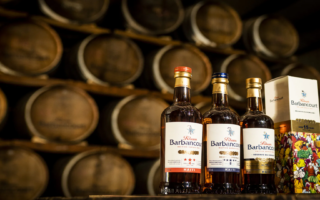Passion for pancakes
Although crêpes are associated with religious festivals, it is a sweet and savoury treat to be enjoyed all year round says Rosa Jackson
Humans have been eating pancakes in some form for 7,000 years, but for me the word will always evoke a crêpe stand near my first Paris apartment. Here, with a back-and-forth swipe of his ingenious device, the crêpe maker would spread the batter evenly over a long rectangular griddle. Once it was golden on one side and dotted with brown spots on the other, he added lashings of Nutella spread, sliced a banana over the top and rolled up the crêpe before giving it to me in a paper cone. As a newcomer to Paris with an untamed sweet tooth, I couldn’t think of a more satisfying meal. It is no accident that I found this crêpe in the area around Gare Montparnasse, near the historic brasseries of La Coupole and Le Select. Trains from Brittany have traditionally terminated at this station, and the first Bretons to arrive in Paris did not wander far from the neighbourhood. Some opened crêperies along Rue du Montparnasse, while others set up simpler stands along the nearby boulevard. Sadly, most of these stands have given way to more profitable enterprises and my original favourite is now a pizza joint.
The Breton passion for crêpes began in the Middle Ages, when the Crusaders brought buckwheat back to northern Europe from Asia. This relative of sorrel and rhubarb, which produces grain-like seeds, thrived in the Breton climate with its sunny spells and frequent rain. First used in breads and to thicken soups and stews, it eventually made its way into a simple batter of flour, water and salt, and the buckwheat galette became a regional staple.
The Bretons sometimes sweetened the galette and flavoured it with orange flower water or cinnamon, but these days it is nearly always reserved for savoury fillings. Crêpes, made with wheat flour (known as froment), can be sweet or savoury, but in a Breton crêperie this more delicate preparation is inevitably served for dessert. Perhaps the most famous sweet recipe, crêpes Suzette, comes not from Brittany but from the Café de Paris in Monte Carlo; it is said that a flustered young disciple of the legendary chef Escoffier accidentally set the crêpes alight while preparing them at the table for the Prince of Wales (the future Edward VII). Recovering his composure, he offered to name this new dessert after the prince, who gallantly volunteered his companion’s name instead.
Eaten more often for dessert than for breakfast in France, crêpes take centre stage at the annual festival of La Chandeleur (Candlemas) on 2 February. Originating as a Roman celebration of fertility called Lupercales, it now marks the presentation of the baby Jesus at the temple 40 days after his birth and the purification of the Virgin. Pope Gelasius, who put an end to the Roman merry-making in 494, also had the idea of feeding crêpes to pilgrims arriving in the city. Since then, pancakes have become synonymous with La Chandeleur, variously symbolising the sun or a good harvest before the sowing of seeds in spring. Protestants associate crêpes with the start of Lent on Mardi Gras (Shrove Tuesday), while in Catholic countries fritters are eaten on that day.
Making crêpes might look easy, but it’s more of an art than a science, according to Gérard Lacroix, who cooks up some of the best in Paris at the Marché Président Wilson on Wednesdays and Saturdays. Each day, he adjusts the liquid in his recipe and the resting time for the batter according to the air humidity. Buckwheat batter can benefit from resting up to ten hours, though sometimes, after only three or four hours, it separates into a watery layer and a thick layer that no longer mix. The less finicky crêpe batter improves with a slow fermentation over 48 hours.
Although even the greatest crêpe makers fail to agree on the basic recipe, the most important rule is to mix the batter gently. Bertrand Larcher, owner of the Breizh Café in Paris, says that carefully mixed batter does not need to rest before being cooked. It is normal for the first crêpe not to turn out, but with a squeeze of lemon and a sprinkling of sugar, it is still sure to disappear.
Crêpes from the Breizh Café
Serves 4
Since opening in the Marais district of Paris a few years ago, Breizh Café has made this neighbourhood the new haunt for crêpe-lovers. It is an offshoot of the original restaurant in the fishing port of Cancale in northern Brittany, and there are also branches in Tokyo (Bertrand Larcher’s wife is Japanese). With top-notch ingredients such as organic stoneground buckwheat flour from Brittany and seaweed or yuzu butter from Breton butter-maker Jean-Yves Bordier, plus oysters from Cancale and a list of exceptional ciders, this is a luxury take on the crêpe but at still-affordable prices. Pale wood tables give it an informal, slightly Japanese feel, and if you want to take some of the products home, the Breizh Café’s épicerie has opened next door. Slightly adapted for the home cook, here is Larcher’s take on the dessert crêpe.
3 organic eggs
75g cane sugar
250g plain organic wheat flour, preferable stone-ground
500ml whole milk
To flavour the batter, one of the following:
10g butter, heated until lightly browned
Seeds of a 2cm-long piece of vanilla pod
½tsp grated orange zest
1tsp rum
1tsp Grand Marnier
Separate one of the eggs and set aside the white. In a bowl, thoroughly whisk the whole eggs, egg yolk and sugar. Add 375ml milk and whisk to combine.
Using a wooden spoon, gently incorporate the flour. Add your chosen flavouring and strain the batter to remove any lumps. At this point, you can let the batter rest if you like.
Before cooking the crêpes, gently stir in the remaining milk. Beat the egg white in a separate bowl until soft peaks form and fold into the batter.
Heat a non-stick frying pan or cast-iron pan over medium heat with a little fat (oil, butter or lard) and pour in enough batter to thinly coat the pan. Cook on one side until golden brown, then flip the crêpe and cook on the other side until lightly browned. Serve immediately.
Breizh Café
109 Rue Vieille du Temple
75003 Paris
Tel: (Fr) 1 42 72 13 77
www.breizhcafe.com
Share to: Facebook Twitter LinkedIn Email


